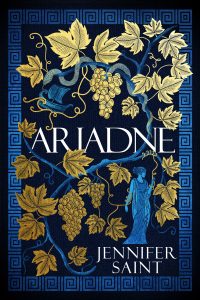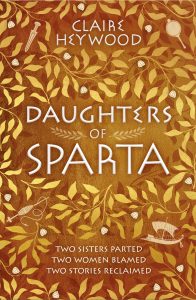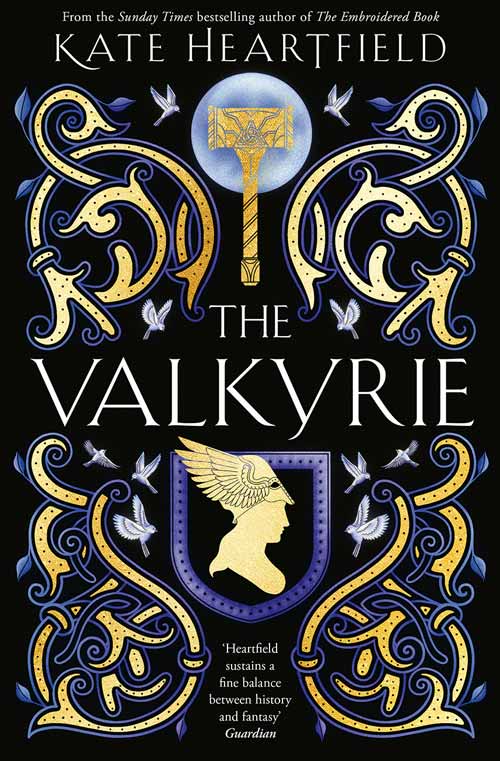Vilified or Victorious?: Claire Heywood and Jennifer Saint Recast the Roles of Women in Ancient Greece and Sparta
WRITTEN BY MYFANWY COOK
 Jennifer Saint’s debut novel Ariadne (Wildfire UK/Flatiron US, 2021) challenges the female stereotypes of Ancient Greece and their vilification by historians throughout the ages. “I have always been interested in Greek mythology,” she says. “When I read Classical Studies for my degree, I was particularly intrigued by Ovid’s Heroides, in which he gave voice to the often-overlooked heroines of myth. In particular, I was drawn to his portrayal of Ariadne and Phaedra as passionate, righteous, and intelligent women.
Jennifer Saint’s debut novel Ariadne (Wildfire UK/Flatiron US, 2021) challenges the female stereotypes of Ancient Greece and their vilification by historians throughout the ages. “I have always been interested in Greek mythology,” she says. “When I read Classical Studies for my degree, I was particularly intrigued by Ovid’s Heroides, in which he gave voice to the often-overlooked heroines of myth. In particular, I was drawn to his portrayal of Ariadne and Phaedra as passionate, righteous, and intelligent women.
“Years later, when I was reading Theseus and the Minotaur to my sons, I was struck by how limited Ariadne’s role often is in other retellings of the story, and that she is only seen in terms of her infatuation with Theseus. I wanted to draw on Ovid’s brilliant portrayal but also to explore her other relationships, not just with men but particularly with her family and her sister, to create a richer and more fully dimensional character.” She admits it was a demanding task to separate the strands of historical fact about Ariadne and her sister from the Minotaur myths and “very challenging to create a believable Bronze Age world in which monsters and gods exist against a landscape that’s unfamiliar to us but recognisable,” she adds. “What we have of the Bronze Age survives in fragments, and the myths come from a tradition of oral storytelling, so we find multiple, often contradictory, versions of the characters and the events which shape their lives.”
For Saint, sifting out verifiable facts felt like “getting lost in a Labyrinth in itself!” she says. “It can be difficult to piece together the details of everyday life that make the novel feel realistic and inhabitable when so much of that ancient past is lost to us, but it was very important to me to do the best job that I could in making the details of their world feel textured and as immersive as I could, so that the fantastical elements of the story would ring true as well.”
Claire Heywood was also faced with separating the strands of historical fact about Helen and Klytemnestra from the myths surrounding the Trojan Wars when researching her debut novel Daughters of Sparta (Hodder & Stoughton UK/Dutton US, 2021).
One of the reasons she decided to undertake this project was her fascination with “the myth, of course,” she says, “but I also wanted to get at the real women beneath it, to imagine what their lives might have been like if they had really existed in the historic milieu of the Greek Bronze Age. It was certainly a challenge, and I had to make decisions about the kind of story I wanted to tell.” Taking the myth as her frame, she continues, “I wanted to make fact my priority. Our evidence for the culture of the Late Bronze Age is naturally limited – it being more than three thousand years ago and predating recorded history. While this granted me a generous degree of creative licence, I also wanted to make sure that I did not contradict any evidence we do have for the period.
“This historicised, realist approach to the retelling meant that if an element of the myth could not reasonably have happened within my historic setting, then it didn’t go into the story. It also meant no meddling gods and no supernatural events. Instead, I wanted to find more human explanations for these turns in the narrative…what drove the characters to act as they did? How did their relationships to one another bring about a war to end a civilisation? What parts of the story had we never been told? So, although Daughters of Sparta is on the one hand a retelling of a traditional and familiar myth, it is also an imagined ‘secret history’ of the real people who may, if they ever lived, have inspired this great story.”
For Saint, one significant element that drew her attention to Ariadne and Phaedra, and that she hadn’t seen developed anywhere, was that “they were sisters who both grew up with the Minotaur and were linked to Theseus. Despite their closeness, their stories always seem to be told independently of each other.” As a result, Saint became interested in “exploring how their shared childhood would have shaped them – the suffering of their mother for their father’s crime against Poseidon, the horror of the Minotaur imprisoned beneath the floor at Knossos, the flow of human sacrifices from Athens to Crete, and then their separation when Ariadne betrays the family and runs away. I wanted to bring them together and delve into the dynamic between them and how that would change as their lives take shape.”
The research she carried out also influenced the physical description of her main characters. “Ariadne and Phaedra are granddaughters of Helios, the sun-god, so I incorporated a lot of bronze and golden tones into my description of the sisters’ hair and eyes to reflect their divine heritage.” Separating the bad press about her characters and the propaganda about them was difficult, because Saint realised that “Phaedra’s story in particular plays into a misogynistic propaganda that we still unfortunately see in modern life. Punished for the hubris of Hippolytus, Phaedra is cursed by Aphrodite to suffer a powerful and doomed unrequited love, and she is notorious for bringing about disaster with a false rape allegation.”
She discovered when carrying out her research that “false allegations of rape are extremely rare, but victims of sexual assault are often not believed, and rape convictions are consequently shockingly low. Men’s reputations are prized above women’s suffering, from the Bronze Age to today. I knew from the beginning that I was going to tell Phaedra’s story in a different way and that the myth of the ‘malicious and deceitful female accuser’ was not a myth that I was prepared to propagate any further.”
 Heywood believes the reason her main characters Helen and Klytemnestra have often been vilified is that “they acted as embodiments of male fears about women – in this case the fear of marital infidelity. In ancient Greece it was perfectly acceptable, even encouraged, for men to take lovers (both male and female); however, for a woman to do so was intolerable, and something which was strictly guarded against. In Classical Athens, for example, married women were cloistered within the home and rarely interacted with men to whom they were not related. Should the unthinkable happen, it was legally permissible for a man to murder his wife’s lover if they were caught in flagrante.”
Heywood believes the reason her main characters Helen and Klytemnestra have often been vilified is that “they acted as embodiments of male fears about women – in this case the fear of marital infidelity. In ancient Greece it was perfectly acceptable, even encouraged, for men to take lovers (both male and female); however, for a woman to do so was intolerable, and something which was strictly guarded against. In Classical Athens, for example, married women were cloistered within the home and rarely interacted with men to whom they were not related. Should the unthinkable happen, it was legally permissible for a man to murder his wife’s lover if they were caught in flagrante.”
Therefore, as Heywood elucidates, we can see “how Helen and Klytemnestra – who both flagrantly transgress the bonds of marriage – would have been shocking figures to such an audience. Not only are their stories irresistibly scandalous, but these two sisters stood like warning signs for how dangerous disobedient women can be. Helen and Klytemnestra became the archetypal ‘bad wives’ both in ancient Greece and beyond.”
In Klytemnestra’s case, she continues, “the fear she invoked was not only connected to her unfaithfulness but also to her cleverness. In Aeschylus’ Oresteia she is characterised as having an unnatural, masculine intelligence, which she uses to scheme and manipulate for her own gain, and the old men who make up the chorus in the first part of the trilogy, Agamemnon, are powerless to stop or even challenge her. In this situation, it is clear that Aeschylus’ villainous portrayal of Klytemnestra is a way of playing out men’s fear toward capable women.”
Does writing about such powerful women in Classical times have any relevance today? “I was surprised to discover just how timeless and relevant Ariadne’s story felt as I was researching and writing,” Saint says. “Ariadne is an idealistic young woman when she meets Theseus, and she falls for his heroic tales and the image that he creates of himself. Although their bond is forged in the heightened drama of their plan to murder the Minotaur together, her experience of love, disillusionment and heartbreak is a familiar one.” For her, the stories she “wove in around Ariadne’s, particularly Medusa’s story, which plays a significant role – with the theme of women being blamed for the behaviour of men – has many stark parallels in today’s society, even without the influence of the cruel and capricious immortals of myth.”
Heywood also highlights the relevance of Helen’s and Klytemnestra’s stories: “Many of the challenges which my characters face are relevant to women today. Across the world women still fight for control over their lives and bodies. While writing Daughters of Sparta I often came across current news stories which were directly related to the issues I was exploring: child marriage, denial of access to contraception, denial of abortion rights, barriers for girls accessing education. These are issues which continue to hold women back from seizing their autonomy and using it to flourish.”
However, she acknowledges, “beyond these more obvious violations of female autonomy, there are more insidious factors which can make the modern female experience feel limited or unjust. Why is female sexuality more guarded than male sexuality? How do we juggle the expectations of motherhood with the pursuit of our own fulfilment? Why is a woman who commits violence, or abandons her family, or behaves promiscuously so much more despicable than a man? Ancient women may have asked themselves these very same questions.”
The hidden lives of the women that Heywood and Saint have described in their novels have been revealed as far from villainous. Instead, they stand out as unvanquished and victorious for breaking the conventions of their time and rebelling against the roles they had been cast in as women living in the age they inhabited.
ABOUT THE CONTRIBUTOR: Myfanwy Cook is the editor of HNR’s New Voices column. For more information, visit www.myfanwycook.com.
Published in Historical Novels Review | Issue 97 (August 2021)






